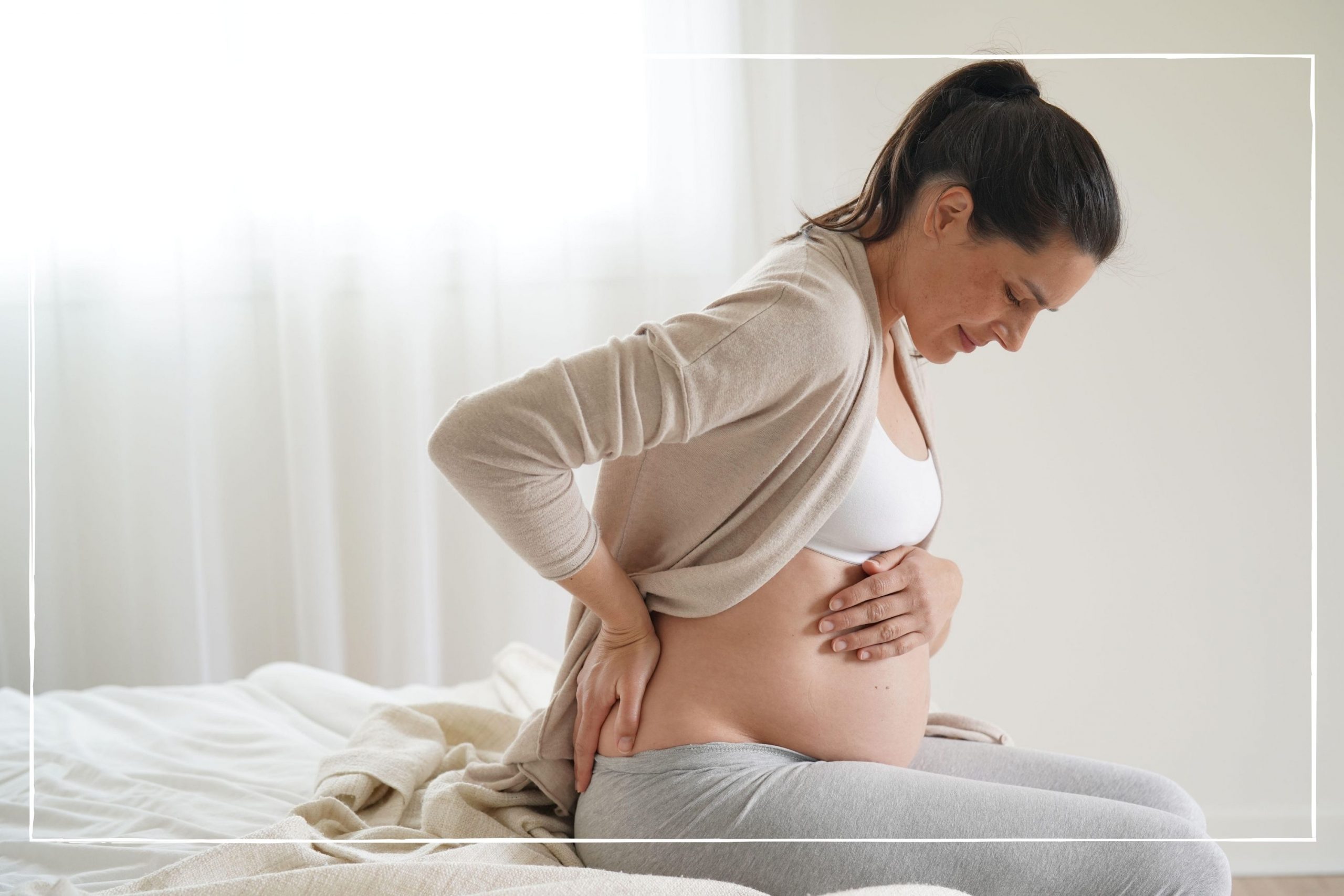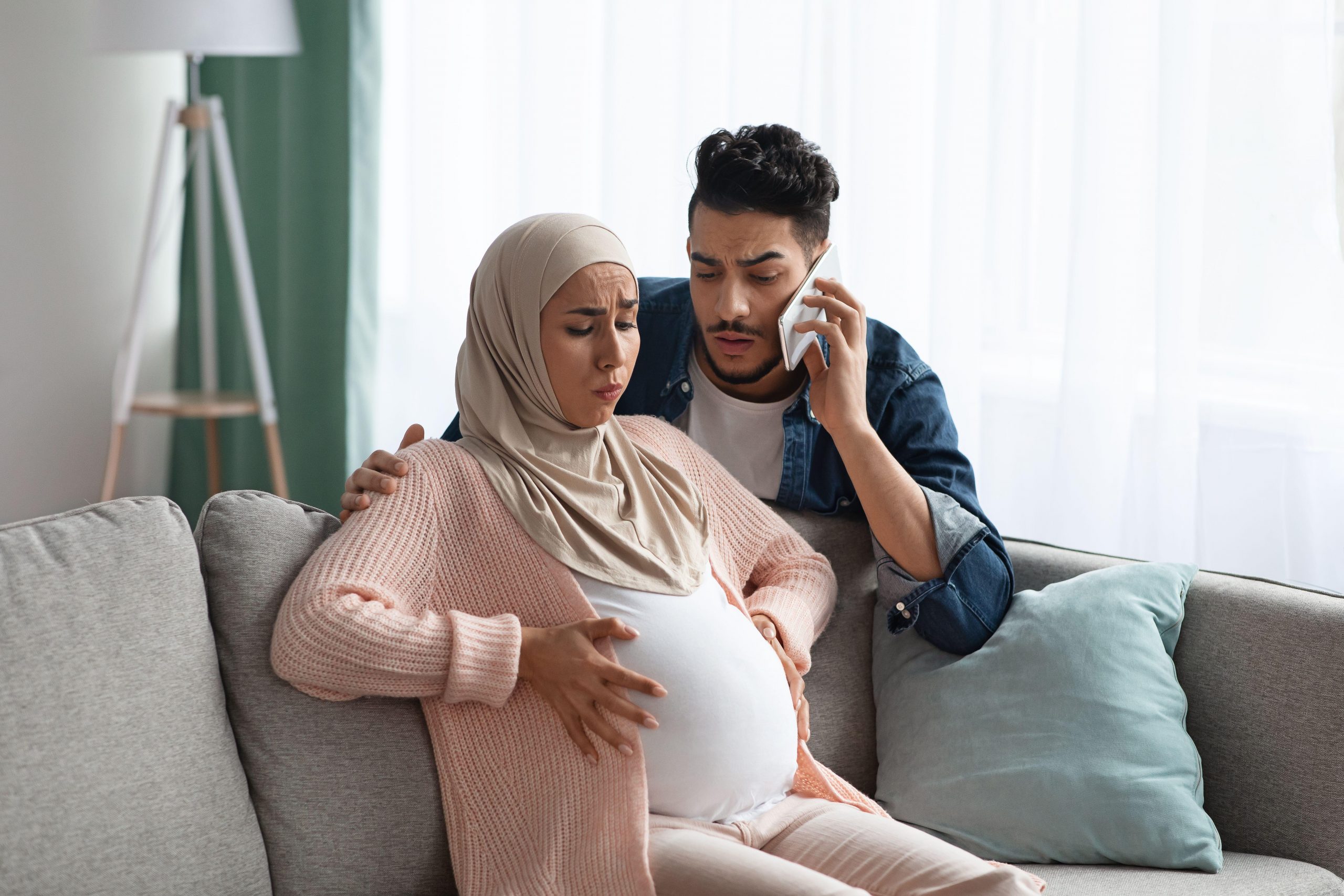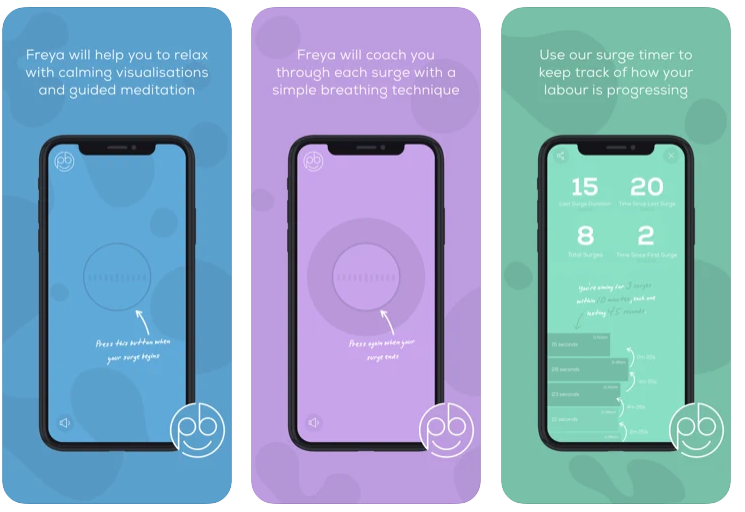Contractions in pregnancy - different types and what they mean


As you get closer to your due date, you may begin to wonder about all the different types of contractions in pregnancy. Perhaps you're experiencing contractions now and you're not sure what to do. We've spoken to registered midwife Sheena Byrom about what to expect.
Sheena Byrom of All4Maternity, who has been a Registered Midwife for over 40 years, compares contractions in pregnancy. Recognising and distinguishing between types of contractions in pregnancy can be confusing. You might start feeling some contractions in pregnancy as early as the second or third trimester, but these usually won’t be the start of labour.
Sheena told us, "Distinguishing between types of contractions is about frequency, duration and intensity. Early contractions feel like period pains. They can usually relieved easily to start with. However, active labour contractions are very intense. They help dilate and thin (efface) the cervix. They are powerful surges that push your baby down.”
Contractions in pregnancy
1) Braxton Hicks contractions
Braxton Hicks contractions are often known as 'false labour pains'. Although they happen when the body is getting ready for labour, they don't indicate that labour has actually started. Midwife Sheena Byrom says Braxton Hicks contractions in pregnancy "can be very confusing". However, she explains, "Braxton Hicks contractions don't increase in intensity. They're rarely painful, they're temporary and rarely have a pattern."
Braxton Hicks contractions in pregnancy are tightenings that many women will find uncomfortable. Medical studies show they can start at 6 weeks but won’t be felt until you’re in your second or third trimester. Sometimes known as “practice” contractions in pregnancy, they help your uterus ready itself for labour.
Recognising Braxton Hicks contractions Braxton Hicks contractions in pregnancy vary in strength and how long they last. They do not form a recognisable pattern. They happen infrequently and are uncomfortable rather than painful.
What do Braxton Hicks contractions mean? Studies show that Braxton Hicks contractions in pregnancy can happen when you’ve not been resting enough, you have a full bladder or you have not had enough to drink. They don’t mean that you are about to start labour. They are completely normal, but not all women will experience them.
GoodtoKnow Newsletter
Parenting advice, hot topics, best buys and family finance tips delivered straight to your inbox.
How to deal with Braxton Hicks contractions If you’re feeling uncomfortable because of your Braxton Hicks contractions, visit the toilet, sit down and have a drink. If you’re worried about your contractions and you have any vaginal bleeding, your waters break or you are in a lot of pain, contact your maternity unit immediately.
2) Early labour contractions
Early labour contractions are an important first step towards meeting your new baby. Midwife Sheena Byrom explains, “They may feel uncomfortable, like period pains, and they differ from Braxton Hicks because they will eventually increase in their intensity. The earliest contractions in pregnancy don’t necessarily open your cervix. These early contractions soften and thin (efface) your cervix. This helps it move it into position, ready for the later stages of labour”.
Why can early labour contractions start?
According to many experts, “the exact sequence of events that leads to uterine contractions is still largely unknown”. However, studies show that hormones, including oxytocin, progesterone and oestrogen, play an important part in starting labour. Early labour contractions in pregnancy can be accompanied by other early signs of labour. These include loss of the mucus plug, back pain and sometimes even diarrhoea. Some women will find their water breaks before contractions start, whilst others might not. The individual experience of early labour is different for every woman and every pregnancy.
When should I be concerned about early contractions?
Most women won’t experience these first early labour contractions in pregnancy until they reach the third trimester. However, some women might experience them too early. If you start to feel early labour contractions that are painful and regular earlier than 37 weeks, contact your maternity unit immediately.
When to tell your midwife you are in labour
If you are at term (37 weeks onwards) then you are likely to welcome labour, even if you are a bit anxious. It won’t be long until you meet your new baby. Call your maternity unit for advice if you’re worried. Always call for help if you experience smelly/discoloured waters, a change in your baby’s movements or you are bleeding.
If you are planning to give birth in hospital or a birth centre, your midwife will tell you to stay at home until your contractions are in a regular pattern. They will tell you what you should be looking for in your contractions. They'll help you recognise the pattern in terms of frequency, duration and intervals between contractions. However, if your contractions are strong and you need pain relief, don’t hesitate to get in touch with them.
3) Labour contractions
The contractions in pregnancy when you are in full, active labour can be very intense. “Contraction timing is the way that midwives measure how far along in your labour you are. Contractions, in general, get more and more frequent and last longer. Some women can have a very fast labour, whereas others will take longer,” explains Sheena, who has seen many births in her 40 years as a Registered midwife.
If this is your first labour, contractions in pregnancy may last from 8 to 12 hours. Labour contractions in pregnancy differ from early labour contractions in that they open your cervix. Your cervix must reach 10cm dilation before your baby can be born vaginally. This is what midwives mean when they talk about being “fully dilated”.
What do labour contractions feel like?
Labour contractions are a far more intense version of the earlier contractions. Some women prefer not to refer to them as painful, and talk about “surges”. Most women opt for pain relief to help them cope with the experience. Contractions begin at the top of the uterus, which is just under your ribs when your baby is fully grown. They squeeze your uterus to press your baby down on your cervix. This helps dilation and will eventually push the baby out. Many women find that they are unable to talk during the most intense labour contractions. They may even make noises that they find quite surprising.
Dealing with labour contraction pain
If you are having a hospital birth you will have access to the full range of pain relief. . This includes an epidural, pethidine and gas and air. If you are having a birth centre birth or a home birth, your options vary. You might be limited to gas and air, paracetamol and the natural relief of water birth.
Everyone’s experience of labour is different. The amount of pain experienced is individual to the mother. It can really vary depending on how many babies she has birthed and baby's position. There are a range of pain management options for dealing with contractions in pregnancy. Take a look at our advice on pain relief in labour.
“When I gave birth for the first time, I found that making low, deep noises like a cow was actually quite helpful in regulating my breathing. My husband and I were quite surprised by it and it made us laugh in between the contractions. Just call me Daisy, I said!” - Naomi, mum of three.

5) Back contractions
Studies show that around 33% of women will experience low-back pain in labour. However, not all women will have back contractions in pregnancy. Back contractions happen when your baby is head down, but facing towards your stomach. Whilst this is a variation of a normal position for a baby, it can be quite uncomfortable. Sometimes your baby will turn to face your back before labour starts. However, when your baby stays in this position, it can cause back contractions in pregnancy and labour.
What do back contractions feel like?
Your baby’s head will be pressing against your spine and your tailbone as you progress through your labour. This is what makes back contractions in pregnancy painful. The contractions will be felt in your lower back, just above your tailbone. Your obstetrician or midwife may be able to help you rotate your baby to relieve back labour pains. Sometimes the back pain will increase during a contraction. Some labouring women find that the pain doesn’t change in between their contractions. A warm bath can be helpful for easing back contractions in pregnancy. You might also benefit from over the counter pain relief and TENS machines.
How will back contractions in pregnancy affect my birth?
Whilst back labour is often described as more painful, this is not true for everyone. Every labour and birth experience is different. Giving birth to your baby is unlikely to be affected by this variation of a normal baby position. If you are finding back contractions painful, ask your midwife for the pain relief you need.
When to worry about back contractions
If you start to feel back labour contractions earlier than 37 weeks, contact your maternity unit immediately. Speak to your midwife if you are in the early stages of labour and you are experiencing high levels of pain. They may advise you to come in earlier or give you advice for dealing with the pain at home.
Nina, 35, a mum of two sons, experienced two labours with back contractions: “I spent so much time in the bath when I was pregnant with my boys. The warm water really helped in early labour. I also used a TENS machine, which felt miraculous at times. The relief it gave me was so helpful.”
6) Sex contractions in pregnancy
Unless you have been told not to have sex or to masturbate during pregnancy, it is safe to do so. It can be a great way to relieve stress, connect with your partner and enjoy yourself. However, many women find that having sex can lead to discomfort afterwards. This might be in the form of contractions. This is caused by the hormone oxytocin, which is involved in increasing contractions in pregnancy during birth.
After-sex contractions in pregnancy are normal and usually nothing to worry about. They are usually caused by oxytocin, which is often called the “love hormone”. Oxytocin is often increased after an orgasm. A rise in oxytocin can also be prompted by the sensual touch involved in making love to your partner. Masturbation is also usually safe in pregnancy. It can cause the same contractions in pregnancy for similar reasons - an increase in oxytocin.
What do after-sex contractions in pregnancy feel like?
The contractions prompted by sex or masturbation are usually not painful. They can be uncomfortable and should subside fairly quickly. Similar to Braxton Hicks contractions, they may feel like period pain.
Can having sex cause labour contractions in pregnancy?
Some women might find that they go into labour after sex. There are lots of myths around natural ways to induce contractions in pregnancy. However, having sex seems to be one of the few ways to do so with any evidence that it works. There are many conflicting studies, but some scientists think labour could be prompted by prostaglandins naturally present within sperm. Prostaglandins are one of the hormones involved in starting labour. They are present during natural labour and used in medical inductions.
Having sex is unlikely to help you to go into labour and start contractions in pregnancy too early. It’s not advisable to have sex after your waters have broken due to the risk of infection.
When should I be concerned about contractions in pregnancy after sex?
If you are less than 37 weeks of pregnancy and you experience contractions, get in touch with your emergency maternity helpline. This is especially important if they do not go away or increase in intensity.
If you are at term - 37 weeks of pregnancy and contractions after sex continue and intensify, you are probably going into labour. Get comfortable and monitor their frequency and intensity. Always contact your midwifery unit for further advice.
Comparing the different types of contractions in pregnancy
Many women find understanding the difference between the different types of contractions difficult, especially if this is their first birth. There is no universally-agreed definition of all the stages of contractions in pregnancy and labour within the field of medicine.
The defining differences between types of contractions in pregnancy are the intensity, frequency, duration and interval of time between them.
| Braxton Hicks contractions | Early labour contractions | Labour contractions |
| Have no real patternAre sporadicAre uncomfortable rather than painfulMight be caused by dehydration, a full bladder or exhaustionDon’t make changes to your cervixGo away after a period of rest | Start to resemble a patternFeel like period painsSoften and thin your cervixIncrease in intensityBecome more frequentIntervals between them become shorter | Are intense and usually you can’t talk during themCan be painful, requiring pain reliefStart from the top of the uterus and ripple down in wavesPush your baby down to dilate the cervixAre in a clear pattern, with short intervals between themPain stops in between each contraction |
Why and how should I track my contractions in pregnancy?
The timing of contractions in pregnancy is an important indicator of how far along you are in labour. They also indicate how well you are progressing. Midwives will use this information to judge when to advise you to come into the birth centre or hospital. If you are having a home birth, your contractions in pregnancy and labour will influence when they are called out. You can time contractions with a stopwatch: simply write down what time they start and stop. However, when you are experiencing a combination of emotions, this might not be the easiest way of tracking your contractions.
Many women find that modern technology helps them keep control of what’s happening. There are many apps that will help you keep track of your contractions. One that has had plenty of recommendations is the Freya app. The app won the Made for Mums award in 2020. Designed by the Positive Birth Company, it helps you relax in between each contraction while you time them.
Understanding your contractions is key to keeping calm and staying in control. A positive mindset is crucial for staying calm and keeping contractions increasing in intensity. The app will even make a recommendation of when to contact your midwife.

Related video: Old wives' tales to predict your baby's gender

Tannice Hemming has worked alongside her local NHS in Kent and Medway since she became a parent and is now a mum of three. As a Maternity Voices Partnership Chair, she bridged the gap between service users (birthing women and people, plus their families) and clinicians, to co-produce improvements in Maternity care. She has also worked as a breastfeeding peer supporter. After founding the Keep Kent Breastfeeding campaign, she regularly appears on KMTV, giving her views and advice on subjects as varied as vaccinations, infant feeding and current affairs affecting families. Two of her proudest achievements include Co-authoring Health Education England’s E-learning on Trauma Informed Care and the Kent and Medway Bump, Birth and Beyond maternity website.